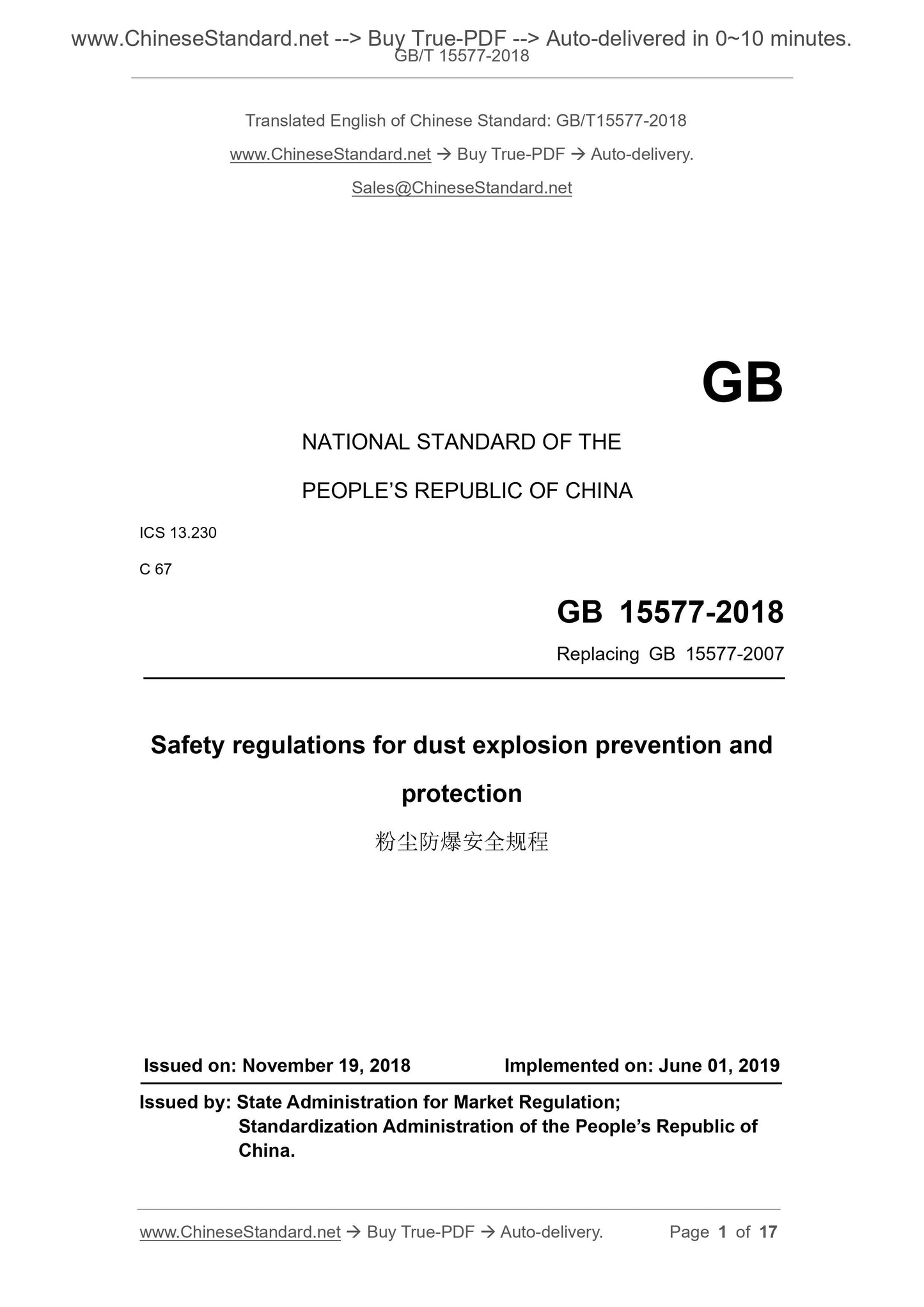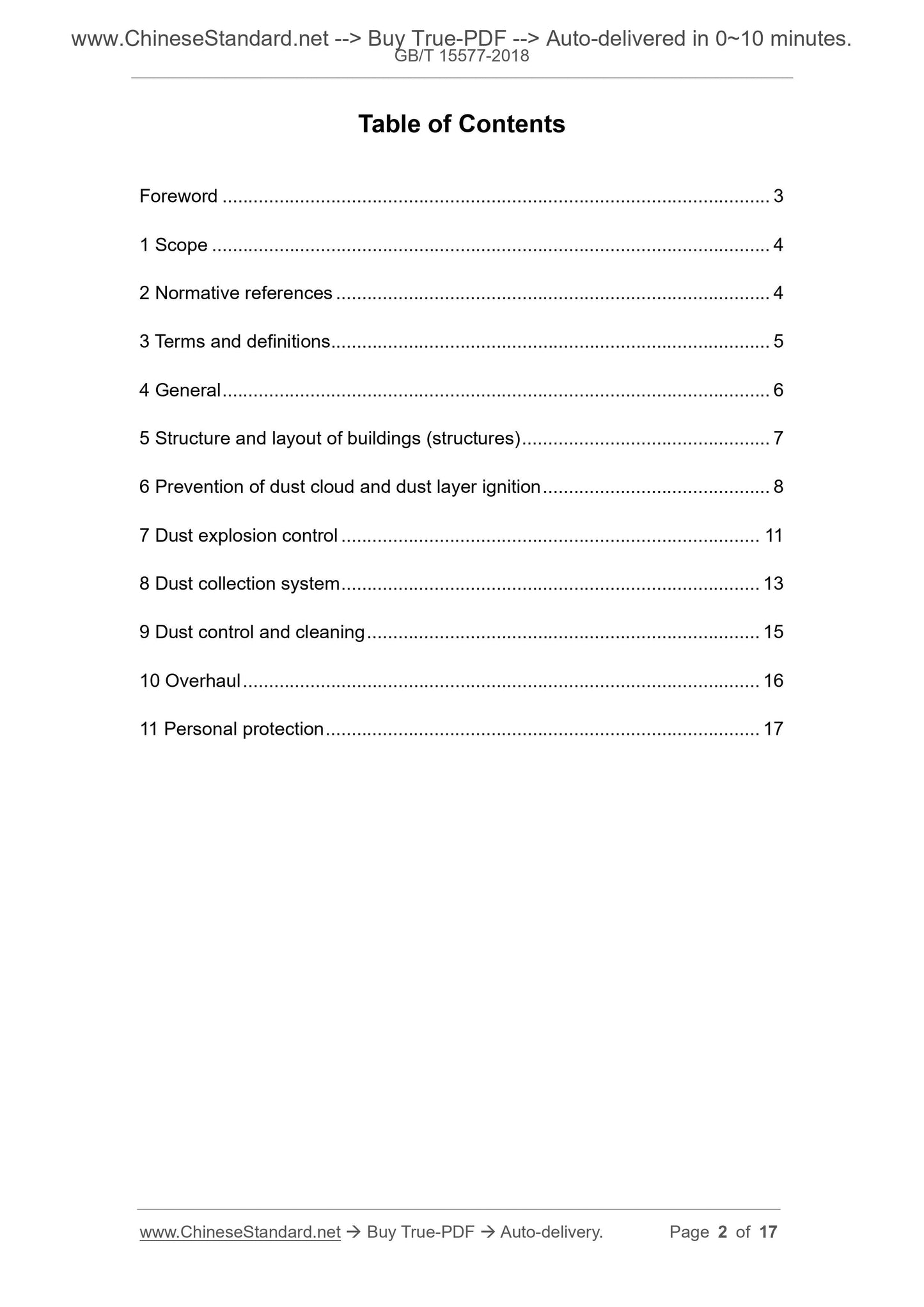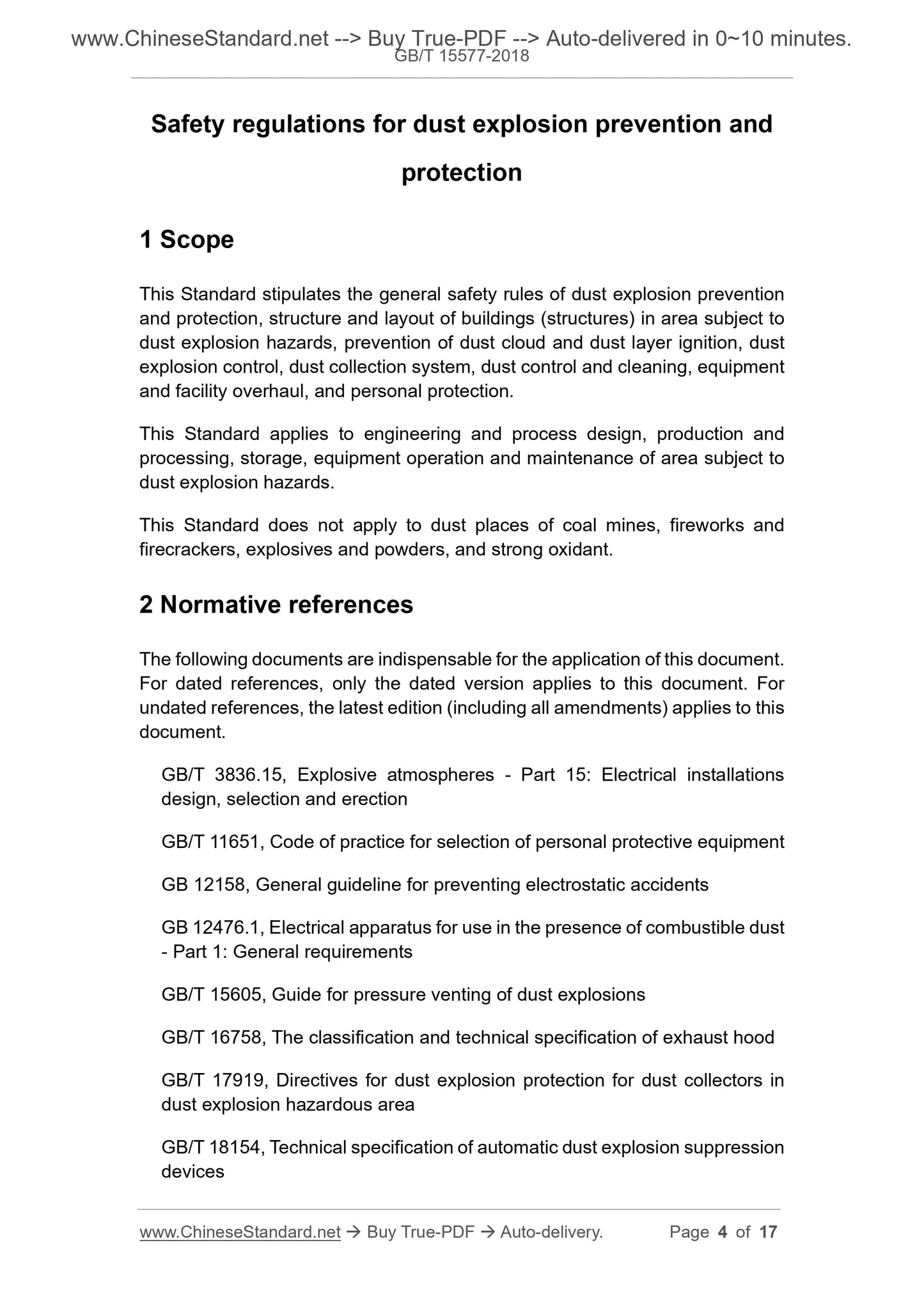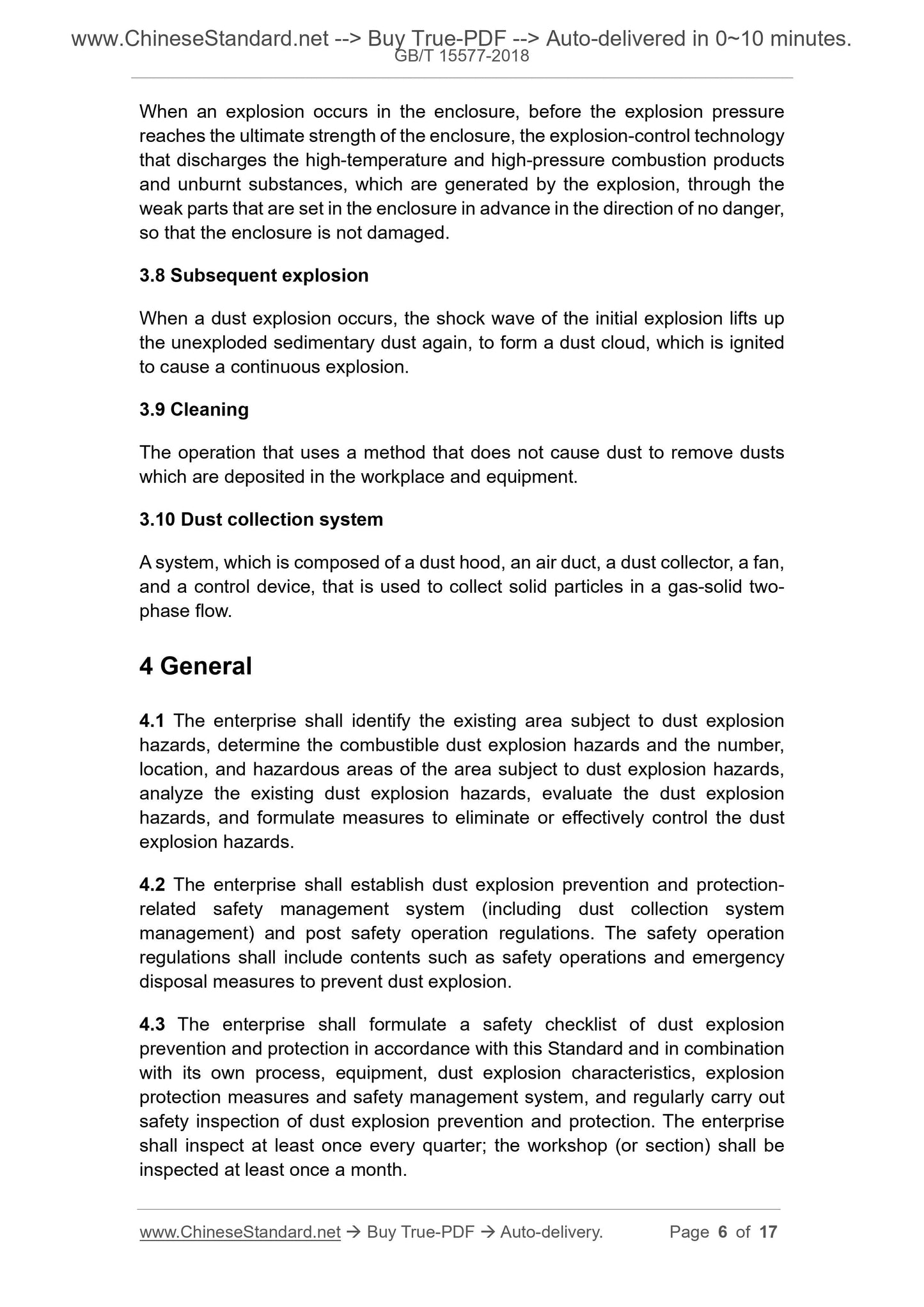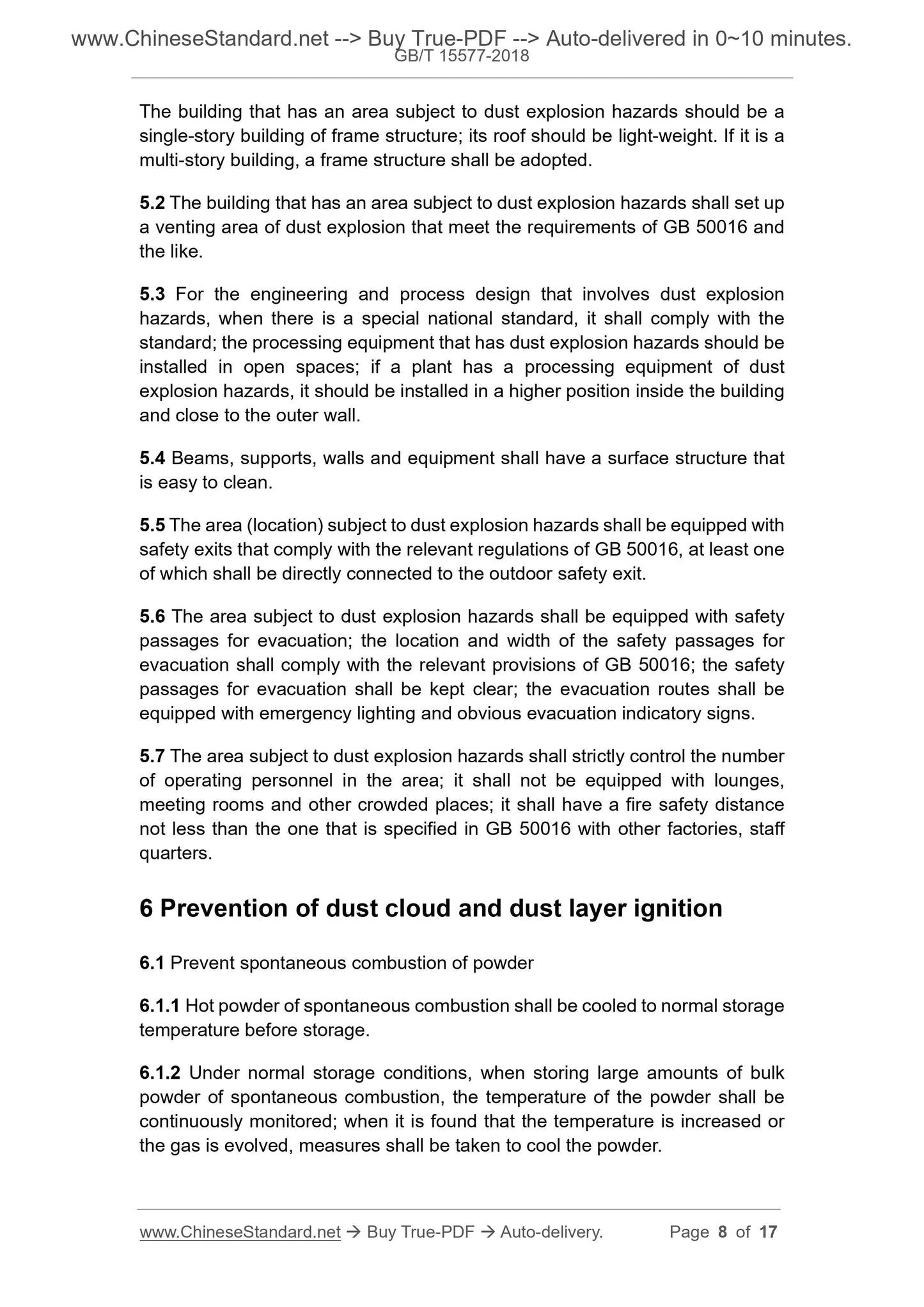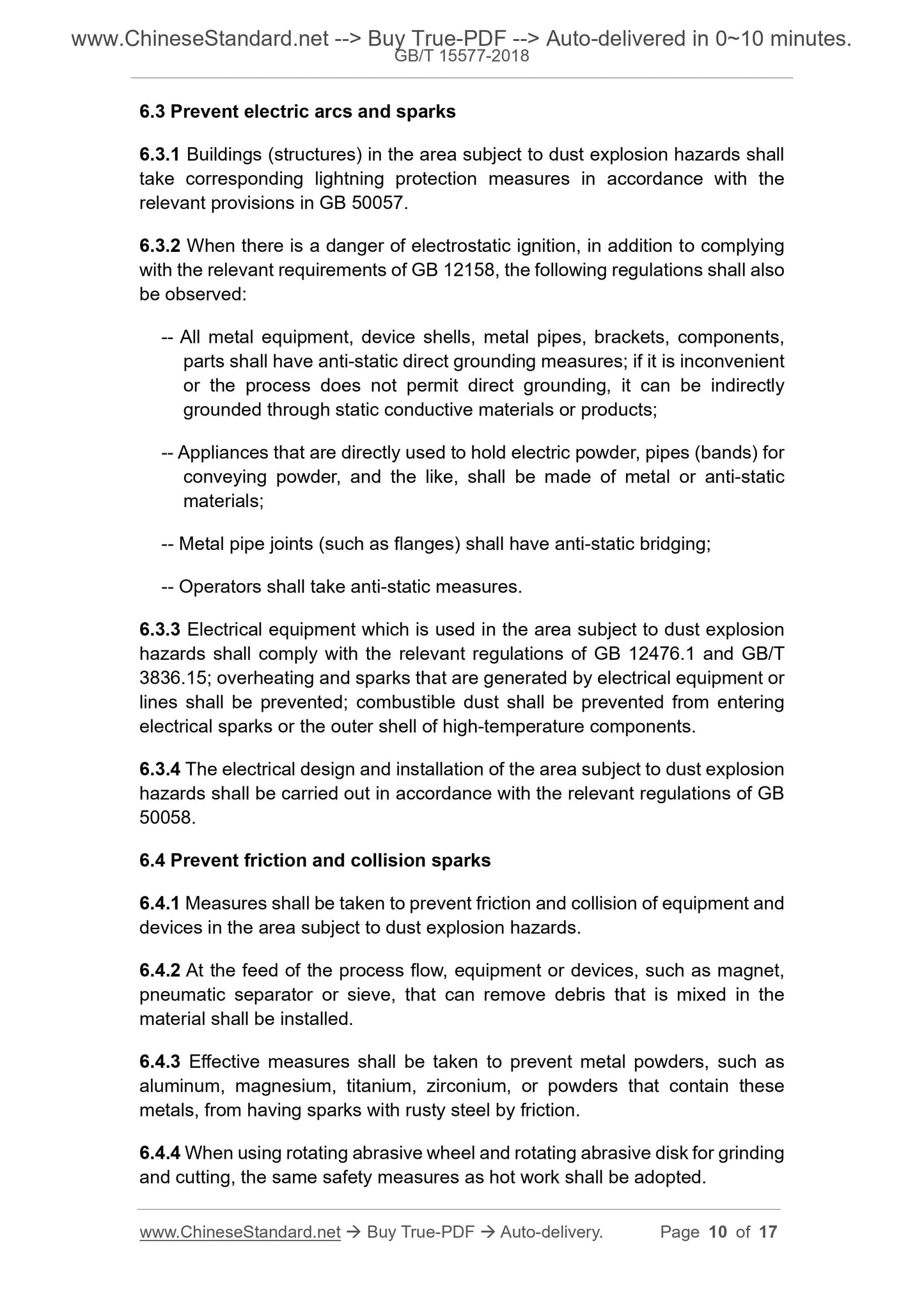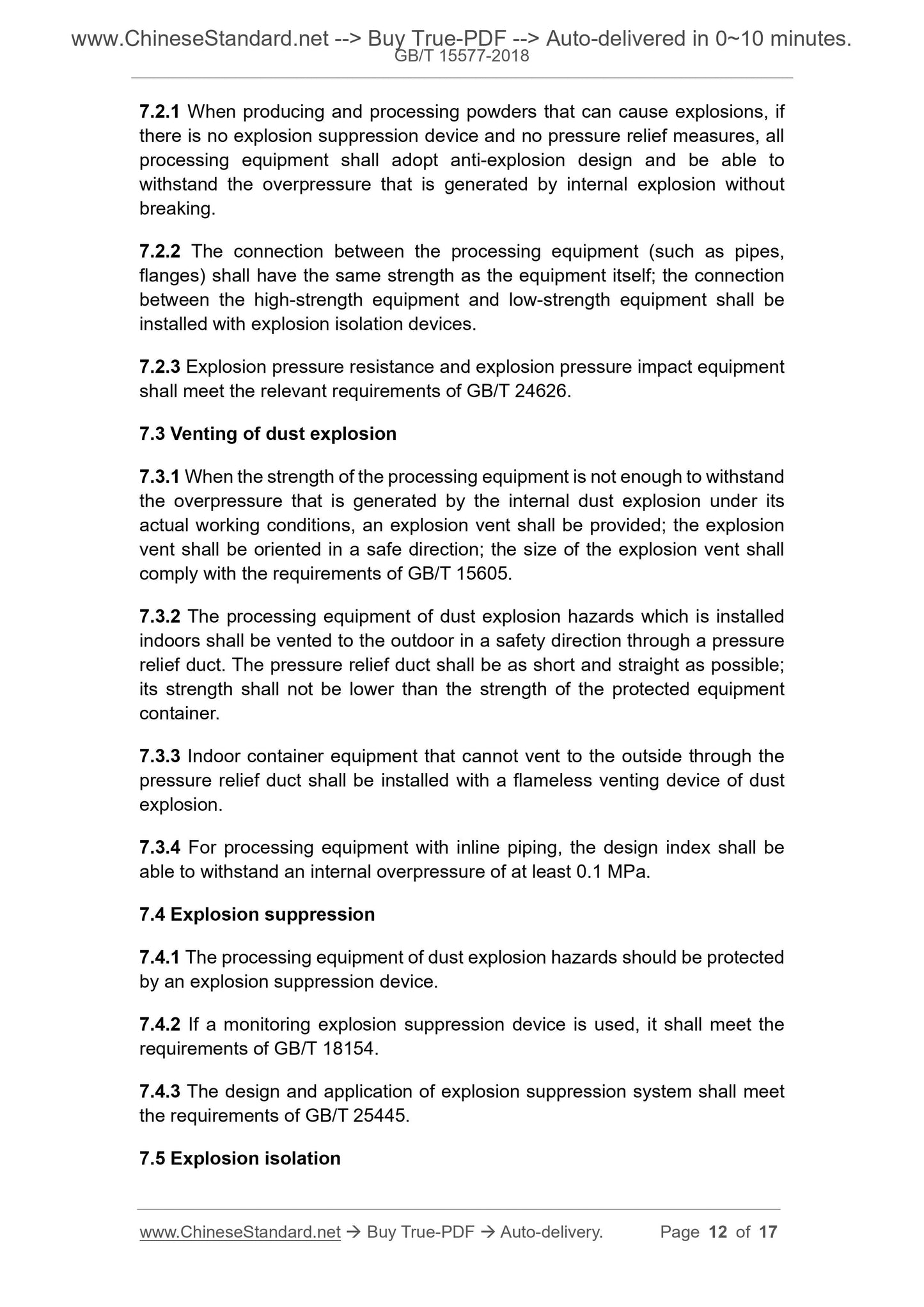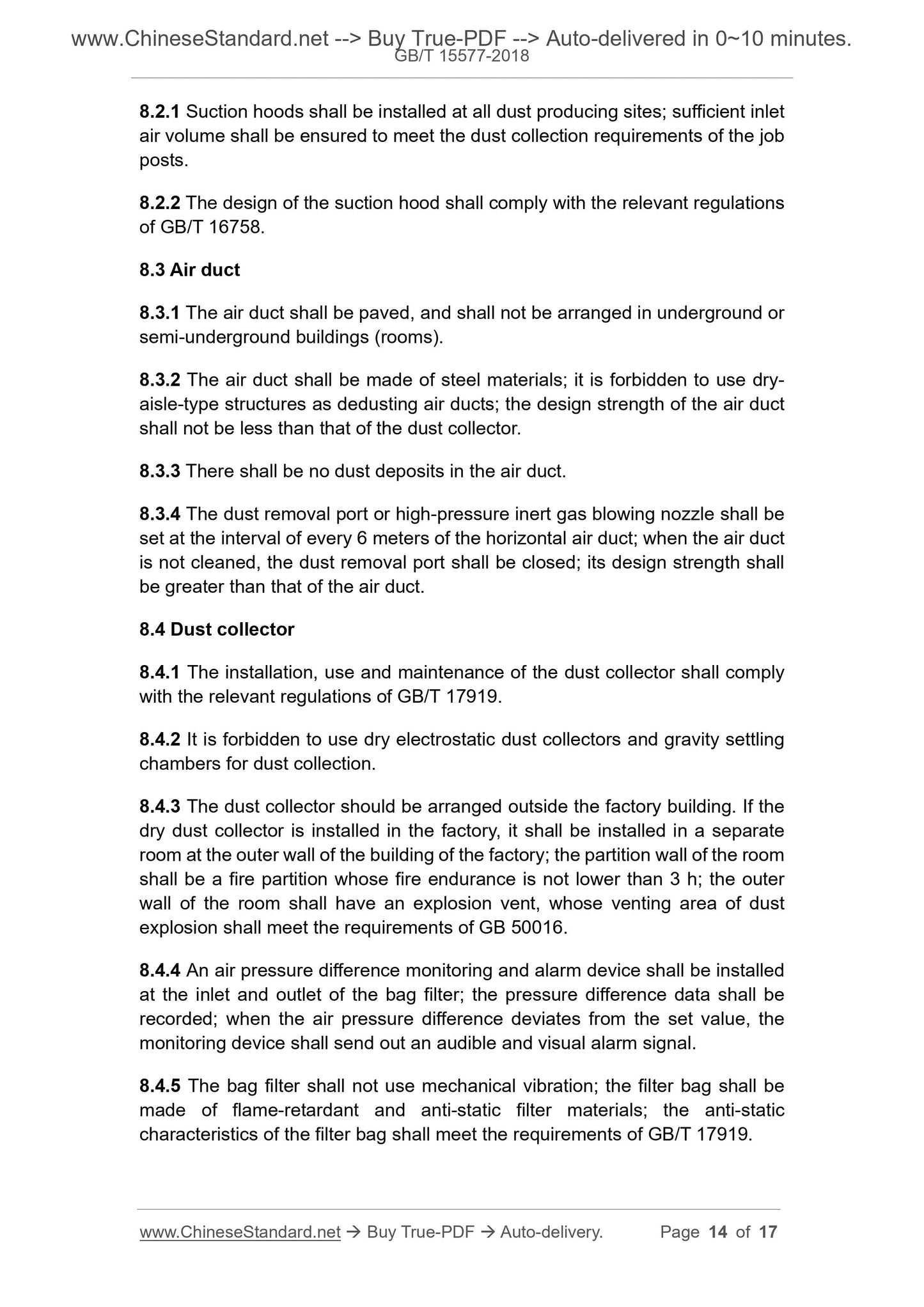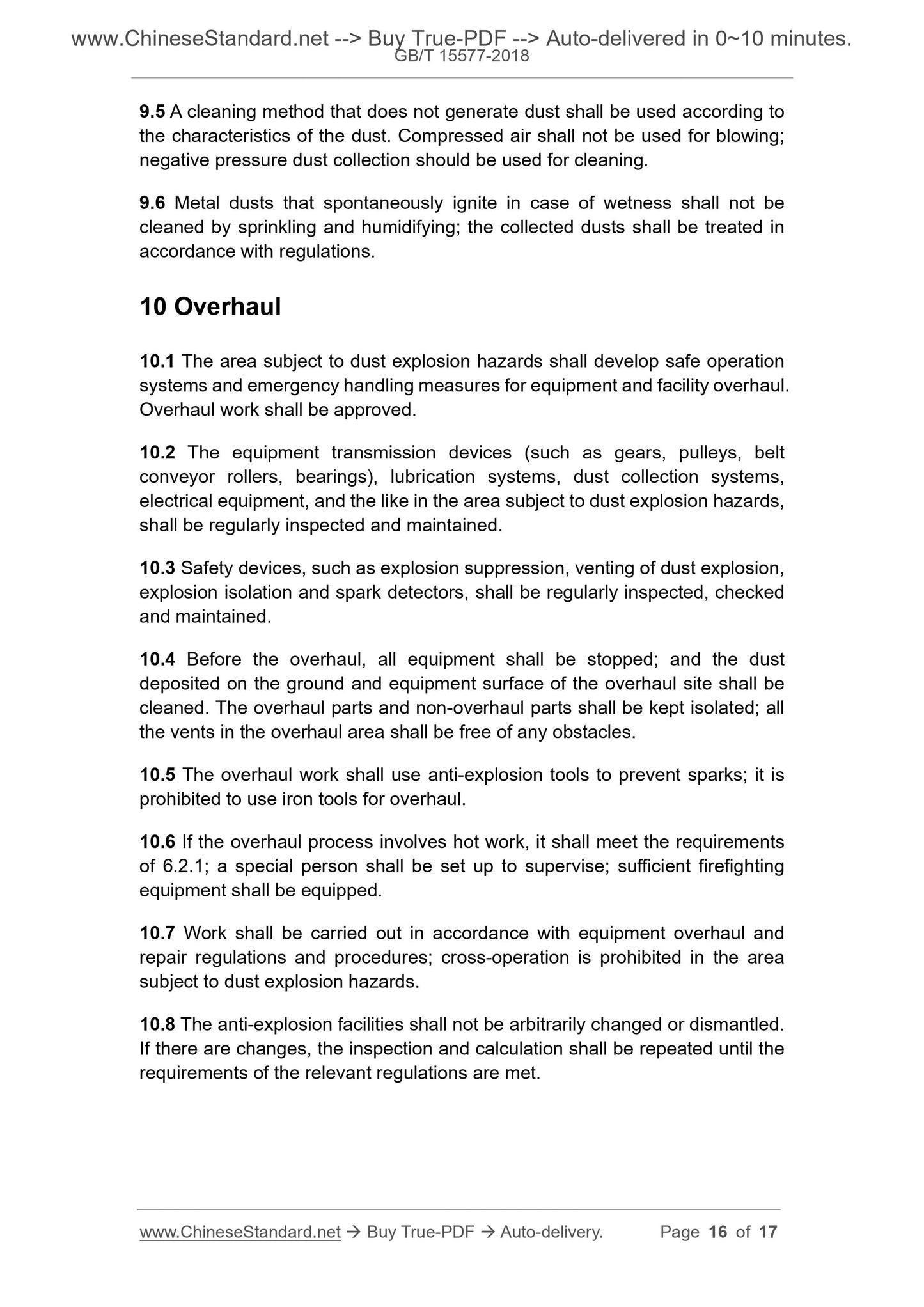1
/
/
9
PayPal, credit cards. Download editable-PDF & invoice in 1 second!
GB 15577-2018 English PDF (GB15577-2018)
GB 15577-2018 English PDF (GB15577-2018)
Normal fiyat
$115.00 USD
Normal fiyat
İndirimli fiyat
$115.00 USD
Birim fiyat
/
/
Kargo, ödeme sayfasında hesaplanır.
Teslim alım stok durumu yüklenemedi
Delivery: 3 seconds. Download true-PDF + Invoice.
Get QUOTATION in 1-minute: Click GB 15577-2018
Historical versions: GB 15577-2018
Preview True-PDF (Reload/Scroll if blank)
GB 15577-2018: Safety regulations for dust explosion prevention and protection
GB/T 15577-2018
NATIONAL STANDARD OF THE
PEOPLE’S REPUBLIC OF CHINA
ICS 13.230
C 67
GB 15577-2018
Replacing GB 15577-2007
Safety regulations for dust explosion prevention and
protection
ISSUED ON: NOVEMBER 19, 2018
IMPLEMENTED ON: JUNE 01, 2019
Issued by: State Administration for Market Regulation;
Standardization Administration of the People’s Republic of
China.
Table of Contents
Foreword ... 3
1 Scope ... 4
2 Normative references ... 4
3 Terms and definitions ... 5
4 General ... 6
5 Structure and layout of buildings (structures) ... 7
6 Prevention of dust cloud and dust layer ignition ... 8
7 Dust explosion control ... 11
8 Dust collection system ... 13
9 Dust control and cleaning ... 15
10 Overhaul ... 16
11 Personal protection ... 17
Safety regulations for dust explosion prevention and
protection
1 Scope
This Standard stipulates the general safety rules of dust explosion prevention
and protection, structure and layout of buildings (structures) in area subject to
dust explosion hazards, prevention of dust cloud and dust layer ignition, dust
explosion control, dust collection system, dust control and cleaning, equipment
and facility overhaul, and personal protection.
This Standard applies to engineering and process design, production and
processing, storage, equipment operation and maintenance of area subject to
dust explosion hazards.
This Standard does not apply to dust places of coal mines, fireworks and
firecrackers, explosives and powders, and strong oxidant.
2 Normative references
The following documents are indispensable for the application of this document.
For dated references, only the dated version applies to this document. For
undated references, the latest edition (including all amendments) applies to this
document.
GB/T 3836.15, Explosive atmospheres - Part 15: Electrical installations
design, selection and erection
GB/T 11651, Code of practice for selection of personal protective equipment
GB 12158, General guideline for preventing electrostatic accidents
GB 12476.1, Electrical apparatus for use in the presence of combustible dust
- Part 1: General requirements
GB/T 15605, Guide for pressure venting of dust explosions
GB/T 16758, The classification and technical specification of exhaust hood
GB/T 17919, Directives for dust explosion protection for dust collectors in
dust explosion hazardous area
GB/T 18154, Technical specification of automatic dust explosion suppression
devices
When an explosion occurs in the enclosure, before the explosion pressure
reaches the ultimate strength of the enclosure, the explosion-control technology
that discharges the high-temperature and high-pressure combustion products
and unburnt substances, which are generated by the explosion, through the
weak parts that are set in the enclosure in advance in the direction of no danger,
so that the enclosure is not damaged.
3.8 Subsequent explosion
When a dust explosion occurs, the shock wave of the initial explosion lifts up
the unexploded sedimentary dust again, to form a dust cloud, which is ignited
to cause a continuous explosion.
3.9 Cleaning
The operation that uses a method that does not cause dust to remove dusts
which are deposited in the workplace and equipment.
3.10 Dust collection system
A system, which is composed of a dust hood, an air duct, a dust collector, a fan,
and a control device, that is used to collect solid particles in a gas-solid two-
phase flow.
4 General
4.1 The enterprise shall identify the existing area subject to dust explosion
hazards, determine the combustible dust explosion hazards and the number,
location, and hazardous areas of the area subject to dust explosion hazards,
analyze the existing dust explosion hazards, evaluate the dust explosion
hazards, and formulate measures to eliminate or effectively control the dust
explosion hazards.
4.2 The enterprise shall establish dust explosion prevention and protection-
related safety management system (including dust collection system
management) and post safety operation regulations. The safety operation
regulations shall include contents such as safety operations and emergency
disposal measures to prevent dust explosion.
4.3 The enterprise shall formulate a safety checklist of dust explosion
prevention and protection in accordance with this Standard and in combination
with its own process, equipment, dust explosion characteristics, explosion
protection measures and safety management system, and regularly carry out
safety inspection of dust explosion prevention and protection. The enterprise
shall inspect at least once every quarter; the workshop (or section) shall be
inspected at least once a month.
The building that has an area subject to dust explosion hazards should be a
single-story building of frame structure; its roof should be light-weight. If it is a
multi-story building, a frame structure shall be adopted.
5.2 The building that has an area subject to dust explosion hazards shall set up
a venting area of dust explosion that meet the requirements of GB 50016 and
the like.
5.3 For the engineering and process design that involves dust explosion
hazards, when there is a special national standard, it shall comply with the
standard; the processing equipment that has dust explosion hazards should be
installed in open spaces; if a plant has a processing equipment of dust
explosion hazards, it should be installed in a higher position inside the building
and close to the outer wall.
5.4 Beams, supports, walls and equipment shall have a surface structure that
is easy to clean.
5.5 The area (location) subject to dust explosion hazards shall be equipped with
safety exits that comply with the relevant regulations of GB 50016, at least one
of which shall be directly connected to the outdoor safety exit.
5.6 The area subject to dust explosion hazards shall be equipped with safety
passages for evacuation; the location and width of the safety passages for
evacuation shall comply with the relevant provisions of GB 50016; the safety
passages for evacuation shall be kept clear; the evacuation routes shall be
equipped with emergency lighting and obvious evacuation indicatory signs.
5.7 The area subject to dust explosion hazards shall strictly control the number
of operating personnel in the area; it shall not be equipped with lounges,
meeting rooms and other crowded places; it shall have a fire safety distance
not less than the one that is specified in GB 50016 with other factories, staff
quarters.
6 Prevention of dust cloud and dust layer ignition
6.1 Prevent spontaneous combustion of powder
6.1.1 Hot powder of spontaneous combustion shall be cooled to normal storage
temperature before storage.
6.1.2 Under normal storage conditions, when storing large amounts of bulk
powder of spontaneous combustion, the temperature of the powder shall be
continuously monitored; when it is found that the temperature is increased or
the gas is evolved, measures shall be taken to cool the powder.
6.3 Prevent electric arcs and sparks
6.3.1 Buildings (structures) in the area subject to dust explosion hazards shall
take corresponding lightning protection measures in accordance with the
relevant provisions in GB 50057.
6.3.2 When there is a danger of electrostatic ignition, in addition to complying
with the relevant requirements of GB 12158, the followin...
Get QUOTATION in 1-minute: Click GB 15577-2018
Historical versions: GB 15577-2018
Preview True-PDF (Reload/Scroll if blank)
GB 15577-2018: Safety regulations for dust explosion prevention and protection
GB/T 15577-2018
NATIONAL STANDARD OF THE
PEOPLE’S REPUBLIC OF CHINA
ICS 13.230
C 67
GB 15577-2018
Replacing GB 15577-2007
Safety regulations for dust explosion prevention and
protection
ISSUED ON: NOVEMBER 19, 2018
IMPLEMENTED ON: JUNE 01, 2019
Issued by: State Administration for Market Regulation;
Standardization Administration of the People’s Republic of
China.
Table of Contents
Foreword ... 3
1 Scope ... 4
2 Normative references ... 4
3 Terms and definitions ... 5
4 General ... 6
5 Structure and layout of buildings (structures) ... 7
6 Prevention of dust cloud and dust layer ignition ... 8
7 Dust explosion control ... 11
8 Dust collection system ... 13
9 Dust control and cleaning ... 15
10 Overhaul ... 16
11 Personal protection ... 17
Safety regulations for dust explosion prevention and
protection
1 Scope
This Standard stipulates the general safety rules of dust explosion prevention
and protection, structure and layout of buildings (structures) in area subject to
dust explosion hazards, prevention of dust cloud and dust layer ignition, dust
explosion control, dust collection system, dust control and cleaning, equipment
and facility overhaul, and personal protection.
This Standard applies to engineering and process design, production and
processing, storage, equipment operation and maintenance of area subject to
dust explosion hazards.
This Standard does not apply to dust places of coal mines, fireworks and
firecrackers, explosives and powders, and strong oxidant.
2 Normative references
The following documents are indispensable for the application of this document.
For dated references, only the dated version applies to this document. For
undated references, the latest edition (including all amendments) applies to this
document.
GB/T 3836.15, Explosive atmospheres - Part 15: Electrical installations
design, selection and erection
GB/T 11651, Code of practice for selection of personal protective equipment
GB 12158, General guideline for preventing electrostatic accidents
GB 12476.1, Electrical apparatus for use in the presence of combustible dust
- Part 1: General requirements
GB/T 15605, Guide for pressure venting of dust explosions
GB/T 16758, The classification and technical specification of exhaust hood
GB/T 17919, Directives for dust explosion protection for dust collectors in
dust explosion hazardous area
GB/T 18154, Technical specification of automatic dust explosion suppression
devices
When an explosion occurs in the enclosure, before the explosion pressure
reaches the ultimate strength of the enclosure, the explosion-control technology
that discharges the high-temperature and high-pressure combustion products
and unburnt substances, which are generated by the explosion, through the
weak parts that are set in the enclosure in advance in the direction of no danger,
so that the enclosure is not damaged.
3.8 Subsequent explosion
When a dust explosion occurs, the shock wave of the initial explosion lifts up
the unexploded sedimentary dust again, to form a dust cloud, which is ignited
to cause a continuous explosion.
3.9 Cleaning
The operation that uses a method that does not cause dust to remove dusts
which are deposited in the workplace and equipment.
3.10 Dust collection system
A system, which is composed of a dust hood, an air duct, a dust collector, a fan,
and a control device, that is used to collect solid particles in a gas-solid two-
phase flow.
4 General
4.1 The enterprise shall identify the existing area subject to dust explosion
hazards, determine the combustible dust explosion hazards and the number,
location, and hazardous areas of the area subject to dust explosion hazards,
analyze the existing dust explosion hazards, evaluate the dust explosion
hazards, and formulate measures to eliminate or effectively control the dust
explosion hazards.
4.2 The enterprise shall establish dust explosion prevention and protection-
related safety management system (including dust collection system
management) and post safety operation regulations. The safety operation
regulations shall include contents such as safety operations and emergency
disposal measures to prevent dust explosion.
4.3 The enterprise shall formulate a safety checklist of dust explosion
prevention and protection in accordance with this Standard and in combination
with its own process, equipment, dust explosion characteristics, explosion
protection measures and safety management system, and regularly carry out
safety inspection of dust explosion prevention and protection. The enterprise
shall inspect at least once every quarter; the workshop (or section) shall be
inspected at least once a month.
The building that has an area subject to dust explosion hazards should be a
single-story building of frame structure; its roof should be light-weight. If it is a
multi-story building, a frame structure shall be adopted.
5.2 The building that has an area subject to dust explosion hazards shall set up
a venting area of dust explosion that meet the requirements of GB 50016 and
the like.
5.3 For the engineering and process design that involves dust explosion
hazards, when there is a special national standard, it shall comply with the
standard; the processing equipment that has dust explosion hazards should be
installed in open spaces; if a plant has a processing equipment of dust
explosion hazards, it should be installed in a higher position inside the building
and close to the outer wall.
5.4 Beams, supports, walls and equipment shall have a surface structure that
is easy to clean.
5.5 The area (location) subject to dust explosion hazards shall be equipped with
safety exits that comply with the relevant regulations of GB 50016, at least one
of which shall be directly connected to the outdoor safety exit.
5.6 The area subject to dust explosion hazards shall be equipped with safety
passages for evacuation; the location and width of the safety passages for
evacuation shall comply with the relevant provisions of GB 50016; the safety
passages for evacuation shall be kept clear; the evacuation routes shall be
equipped with emergency lighting and obvious evacuation indicatory signs.
5.7 The area subject to dust explosion hazards shall strictly control the number
of operating personnel in the area; it shall not be equipped with lounges,
meeting rooms and other crowded places; it shall have a fire safety distance
not less than the one that is specified in GB 50016 with other factories, staff
quarters.
6 Prevention of dust cloud and dust layer ignition
6.1 Prevent spontaneous combustion of powder
6.1.1 Hot powder of spontaneous combustion shall be cooled to normal storage
temperature before storage.
6.1.2 Under normal storage conditions, when storing large amounts of bulk
powder of spontaneous combustion, the temperature of the powder shall be
continuously monitored; when it is found that the temperature is increased or
the gas is evolved, measures shall be taken to cool the powder.
6.3 Prevent electric arcs and sparks
6.3.1 Buildings (structures) in the area subject to dust explosion hazards shall
take corresponding lightning protection measures in accordance with the
relevant provisions in GB 50057.
6.3.2 When there is a danger of electrostatic ignition, in addition to complying
with the relevant requirements of GB 12158, the followin...
Share
